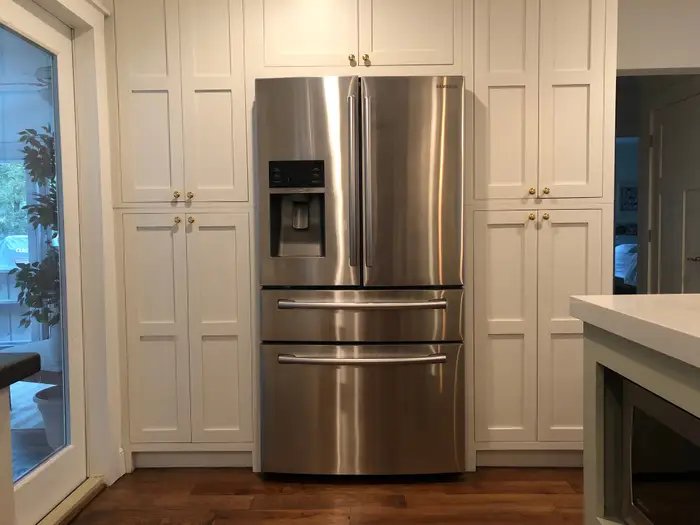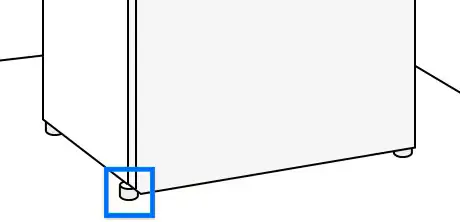
First, refrigerators make fan noises during regular operation (cooling cycles, defrost cycles). However, if the noise is significantly louder than usual, new, or has a distinct rattling/grinding quality, it likely indicates a problem.
So, if you suspect a fan is the culprit. Here’s a breakdown of what might be causing it and how to address it.
1. The most common cause is Ice Buildup
which is very frequent. Ice can build up around the evaporator fan (inside the freezer compartment, behind a panel) or sometimes the ice maker fan. When the fan blades spin, they hit the ice, causing rattling, buzzing, or grinding noises. This often happens if the defrost cycle isn’t working properly or the door seal is poor, letting moist air in. The following video is an example of how to fix it.
2. Condenser Fan Issues.
This fan is located at the back or bottom of the fridge near the compressor. There are two possibilities here:
- Dirt/Debris: Dust and pet hair can accumulate on the condenser coils and the fan itself, making the fan work harder and potentially becoming noisy or obstructed.
- Motor Failure: The condenser fan motor might wear out, leading to humming, grinding, or squealing sounds.
So we should check the Condenser. If the condenser coils are causing the noise, we should clean them. If the motor fails, we should replace it. The following video tells you how to clean it from 540s
3. Evaporator Fan Motor Failure
Like the condenser fan, the motor for the fan inside the freezer can fail, causing similar noises (grinding, squealing, loud humming). The first video shows the Evaporator Fan at 2min30s; if the motor fails, we should replace it.
4. Other reasons
- Obstruction: Something might be physically blocking one of the fans (e.g., a loose wire, piece of packaging, or debris).
- Loose Mounting: A fan might be vibrating because its mounting screws or housing have become loose.
If the reason is obstruction, when we check the fan, we can clearly find it. If the reason is Loose Mounting, we should adjust it like the image below.

Several possible reasons have been mentioned above, but when troubleshooting, if you want to find out the problem quickly, it is best to troubleshoot according to the following list. Regarding the Ice Buildup problem, in the video, a hair dryer is used to melt the ice. We can also perform a Manual Defrost to solve it.
Troubleshooting Steps & Potential Solutions (What You Can Try):
- Identify the Fan: Try to pinpoint where the noise is coming from:
- Inside the freezer: Likely the evaporator fan.
- Back or bottom (outside): Likely the condenser fan.
- Perform a Manual Defrost (Addresses Ice Buildup):
- Important: Unplug the refrigerator.
- Empty the fridge and freezer. Store food in coolers.
- Leave the doors open for at least 8-24 hours (longer is better, especially if it’s heavily iced). Place towels around the base to catch the melting water.
- Once defrosted, clean up any water, plug the fridge back in, and allow it several hours to reach the set temperatures before reloading food.
- Listen to see if the noise has gone away. If it returns quickly, the defrost system might have an underlying issue (heater, sensor, or control board).
- Clean the Condenser Coils and Fan Area:
- Necessary: Unplug the refrigerator.
- Locate the condenser coils (usually behind a back panel or underneath). Consult your manual if needed.
- Use a vacuum cleaner with a brush attachment and/or a specific coil cleaning brush to gently remove all dust, lint, and debris from the coils and the condenser fan area.
- Plug the fridge back in and listen. Improved airflow can sometimes reduce fan noise.
- Check for Obvious Obstructions: (Only if safe and accessible after unplugging) Briefly look around the fan areas (especially the condenser fan at the back/bottom) to see if anything is visibly hitting the blades.
- Check if the Fridge is Level: An unlevel fridge can sometimes cause vibrations. Ensure it’s stable and level according to the manual’s instructions.
If none of the above solutions work, you’ll likely need a qualified appliance repair technician. They can accurately diagnose which fan (evaporator, condenser, or ice maker) is faulty and replace the necessary part (fan motor assembly). Contact Samsung support or a reputable local appliance repair service.
3. When to Seek Professional Repair:
- If the manual defrost doesn’t solve the noise, or if the noise returns soon after.
- If the noise is a distinct mechanical grinding, whining, or screeching, it strongly suggests a failing motor bearing.
- If cleaning the condenser coils doesn’t help.
- If you are uncomfortable performing any of the troubleshooting steps.
- If the refrigerator is also not cooling correctly.
In summary, the fan noise in your RF28HMEDBSR is often caused by ice buildup hitting the evaporator fan blades or issues with the condenser fan (dirt or motor failure). First, try a thorough manual defrost and cleaning of the condenser coils. Professional diagnosis and repair are likely needed if these steps don’t resolve the problem.
